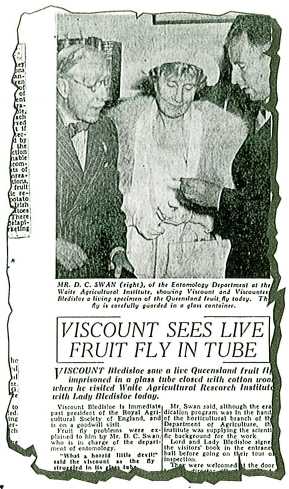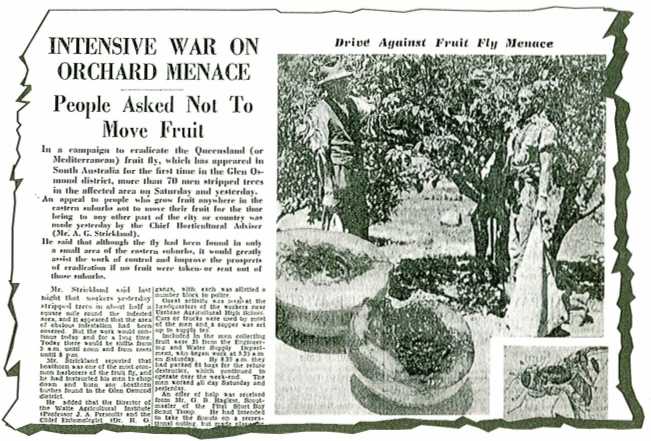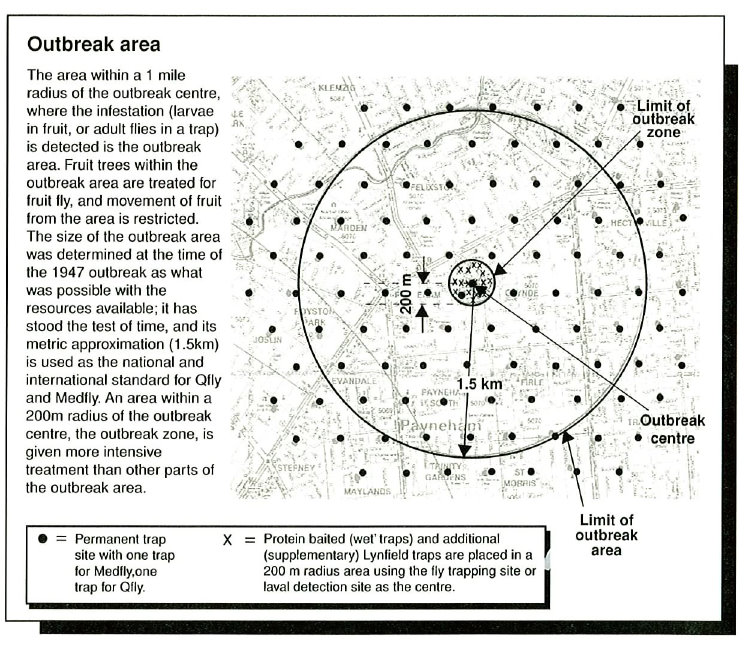1947
The first recorded outbreak of fruit fly in South Australia occurred when larvae were found in nectarines from a tree on a property at the corner of Waite and Grandview Road, Glen Osmond, on 30 January 1947. The gardener took the infested fruit to the nearby Waite Institute. Identification was confirmed when adult Qflies emerged from the infested fruit after incubation by H G Andrewartha, entomologist of the Department of Entomology at the University of Adelaide’s Waite Institute.

An emergency meeting of Executive Council was arranged with the Governor on 31 January to discuss the steps to be taken to proclaim an outbreak and specify procedures. As the Governor, Sir Willoughby Norri, was attending a Test match at the Adelaide Oval at the time, the meeting was held in a room at the Oval. A Proclamation, signed by the Governor, stated that steps were to be taken to ensure that ‘All things necessary to seize or destroy fruit or trees infected (sic) with fruit fly’ were taken.

Within hours of the discovery, decisions were made by the Department of Agriculture and the State Government to eradicate fruit fly and to prevent its establishment in South Australia. This policy has not been varied to the present. The reasons for this policy are to protect the commercial fruit industry in the Riverland and other growing areas of The state and also protection of fruit grown in home gardens in the metropolitan area, where large quantities of fruits and vegetables are grown. At the time, there were few guides to the size of the area to be treated. An outbreak of Medfly had been successfully eradicated from Florida in 1928 by treating an area within a 10 mile radius of the initial outbreak. With this in mind, a meeting of senior staff of the Department of Agriculture with Waite Institute entomologists H.G. (‘Andy’) Andrewartha and Duncan Swan, agreed that treatment of an area within one mile radius of the Glen Osmond Qfly outbreak was a compromise between the Florida experience and the availability of manpower and equipment in Adelaide. Consequent to this meeting, an area within a one mile radius was declared, in which the trees would be stripped of fruit and the foliage baited, A.G. Strickland, Chief Horticulturist, was selected to direct the eradication campaign.
Identification of fruit flies
At the time of the first outbreaks, positive identification of the species of fruit fly was possible only by use of taxonomic keys to identify adults; this meant that larvae had to be reared to the adult stage, which may take a number of weeks.
In 1970, Harry Lower reported a technique to identify the larvae of Qfly and Medfly by microscopical examination of the mouthparts; this enabled identification within one hour. In a few specimens, subjective judgement is necessary, and the technique was not extended to include identification of the larvae of other fruit fly species.
In 1993, a technique of identifying proteins characteristic of each species using cellogel electrophoresis, was adapted from Western Australian research.
In 1997, larvae on which outbreaks are declared are identified to species by cross reference to all three methods.
The policy of eradication of the outbreak was based on likely damage to local, interstate and overseas markets and to home garden fruit and vegetable produce, and the recognition that it was the only opportunity to prevent fruit fly becoming established. This was a clear recognition of the likelihood of fruit flies becoming established in South Australia.
Removal of fruit from backyards
A G Strickland announced that ‘The immediate destruction of the fruit is the only known preventative to the spread of this fly’. Stripping of fruit began on 31 January 1947 with staff for the campaign coming initially from the Department of Agriculture and the Water Supply Department. Primary host fruit (all stone fruit) were removed first, followed by secondary hosts (pome fruit, figs, citrus; the vegetable plants tomato, cucumber, sweet melon). Fruit collected was placed in bags and taken to the refuse destructor in Halifax Street.
On 3 February 1947, an infestation of Qfly was reported from High Street, Glenelg where about 100 acres of gardens were moderately infested. Gangs from the Highways Department, together with their trucks, gangers, foremen and labourers, were mobilised. With two outbreaks, and a large amount of fruit and plants to be removed, additional assistance was required and a call from the Government went out for additional assistance. Help came from Councils and the Engineering and Water Supply Department, university and high school students (on holidays), scouts groups, the Henley Life Saving Club and individual householders in the outbreak areas. A group of 40 fruit growers from the Barossa Valley assisted in stripping fruit during the peak of the outbreaks. (The Government announced that volunteers would be put on the Government payroll.). Bases set up for the campaign were: Glen Osmond - near Urrbrae Agricultural Hugh School; Glenelg - Corner of Anzac Highway and Osborne St.

Treatment in commercial areas included the removal of grapes from around Marion (unripe grapes went to Hamilton’s Winery for spirit distillation), and the removal and destruction of a quince crop and tomato and cucumber crops and plants from properties around Warradale.
Disposal of fruit and plant material
The amount of fruit collected (about 20 tons per day) was too great for the refuse destructor at Halifax Street and a program was developed for bagged fruit (with added stones for weight) to be clumped at sea. The bags of infested fruit were lightly treated with DDT powder and left overnight before dumping.
Initially, loading of barges of the Harbour Board was done from the Glenelg jetty and the bags dumped about 15 to 20 miles out to sea (see photo). As the labour and supervision required was costly and the method was subject to delays caused by rough weather, barges were loaded at Outer Harbour and the fruit dumped at sea. Some bags were known to have broken open after a storm and fruit washed up on Adelaide beaches.
Boxthorns were reported as hosts of fruit fly, and whole bushes were removed from the Glenelg foreshore and around Glen Osmond using four bulldozers and two crawler tractors. Where this was not possible, two power spray units were used to apply an arsenical spray.

Lure traps and sprays
Food-lure traps used to detect adult flies in the outbreak areas were initially made from Agee jars and treacle tins with Clensal (a commercial ammonia-based cleaner) or a vanilla-ammonia solution. Bell-shaped glass traps (McPhail) were used later in the season, with an orange rind extract-ammonia as lure. Only one Qfly was trapped during the first outbreak year, on 26 February 1947.
Bait spraying, using 2 oz tartar emetic (antimony potassium tartrate), 2 lb brown sugar in 4 gal water was applied as 6 fl oz per ‘spot’ at weekly intervals to attract and kill adult fruit flies.
In the peak eradication period of the two outbreaks, about 1300 individuals were employed, and for many weeks over 700 were employed. This proved such a drain on Adelaide’s labour force that sewerage and water-supply work was severely curtailed.
A.G. Strickland acknowledged during the latter stages of the eradication program the willing cooperation that was being provided by householders in the two outbreak areas. Comments from readers in the local papers ‘The Advertiser’, ‘The News’ and ‘The Mail’ on the outbreak of fruit fly and on the eradication program were about equally numbered for and against the measures being taken. Most of those who were against the program were home gardeners who were unaware of the serious nature of the outbreak and of the consequences to home gardeners as well as commercial growers if nothing was done; and wanting compensation for fruit taken from their property. The Minister of Agriculture, Sir George Jenkins, announced in 1948 that claims for compensation for the outbreaks in 1947 came from 971 home gardeners and 39 commercial growers.
